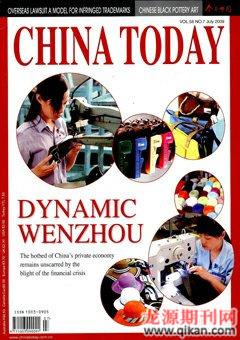Ancient Town Tengchong
LI ZHUOXI WU MEILING
IN Chinas relentlessly beautiful southwest there is a place thatstands out for its unbelievable perfection: Tengchong. An American writer called it a “living landscape painting.” Seeing it, I felt the same way.
In ancient times, merchants who journeyed along the winding legendary southern Silk Road made Tengchong their last stopover. Historians described it simply as the “last town on the Chinese border,” for beyond it were the foreign lands of Myanmar, India and Afghanistan.

Volcano, a View from the Inside out
Once in Tengchong its easy to explore nearby Mount Xiaokong, a dormant volcano. Peering into its mouth, I could make out the graffiti left by tourists. The inside of the volcano, with new comments, names or images scratched into its walls every day, had become a kind of progressive work of pop art. Among all the renderings, one caught my eye that must have been the effort of a group of tourists soon after the disastrous earthquake hit Sichuan in 2008: “Come on Sichuan – You never quit!” Tracing these marks with my finger I made my way into the mouth and slowly descended some 60 meters to the bottom, entering a space another 60 meters or so in diameter. Looking up, I realized the mouth was also quite big, about 200 meters across. Tengchong has nearly 100 such volcanic cones.They open up like variform windows of the earth that let us peep into the universe.
In the heart of this crater, luxuriant vegetation had sprung up. The picture of normal: gentle breezes, an azure sky and snow-white clouds making a backdrop for the trilling of birds in the clear air. Was this the place where Mother Nature once violently released her rage? I wondered, placing small stones into the pattern of a heart, for good luck.
A Bounty of Hot Springs

Local people call the area “hot sea” regarding it as a blessing from nature.With the seething, underground heat of volcanoes often come hot springs. In this case, about 80 founts of escaping water, many scalding to the touch. They gushed upwards noisily while their steam rose quietly to envelope the place.This water bubbles and churns at up to 96.6 ºC, making it unnecessary to light a stove to cook, locals boast.While I strolled the area, some peddlers sold eggs boiled in the water, bound in straw by the half dozen.Close by, other peddlers were promoting their flour buns steamed in pots that use straw hats as covers. As a bread lover, I couldnt resist one.
The Hot Sea area has many outlandish sinter formations shaped by the natural force of springs that have roared, non-stop, for as long as anyone can remember.
Heshun: a Landscape in Eastern and Western Styles
The town is somewhat vertical, starting at the foot of Mount Heilong with its old houses extending up the slope for well over two kilometers. At the entrance to Heshun, a serene and clear mountain stream has served the townsfolk for ages, as evidenced by a couple of man-made spots for doing laundry or washing vegetables. Places like this town were essentially encampments made for women left behind by merchants, who fanned out from them to do business in foreign countries. Today, over 6,000 people are living here and running all manner of enterprises. Apart from exchanging greetings with you, they keep at their work, knowing you are here to enjoy their picturesque home place. Somehow they, like you, are part of this landscape painting or movie, scenes changing dramatically as you pass by.
Life here today epitomizes how mountain people used to live in western Yunnan. Moving at a leisurely pace in the sunset and evening breezes, I followed the age-old flagstone path deep into the town, and wandered through those old houses that have been preserved as showcases of old Heshun. I saw finely crafted furniture in the classic style, embroidery from Suzhou, rattan chairs from Burma, American ovens made in the 1920s, a noodle maker from Japan, a Qing-dynasty ladies vanity, and a huge carved and engraved wooden bed from the Ming Dynasty. Shipping them by horse along the winding roads, thick forests and rocky mountains would have been the only means of getting them to this remote town in those days. No surprise that they would have been so well kept they could be proudly exhibited today.
You could say Heshun is a landscape painting in both Western and Chinese styles. Local people, though their town was cut off, had kept in step with outside trends. By the mid-20th century, this town of 5,000 had sent 7,000 abroad to make their living in 20-some foreign countries. Of all its attractions, architectural or otherwise, the town library is a tourist must – a hybrid of Chinese and foreign architecture rarely seen in any other place. Its 1,392 square meters were commissioned in 1928 with money pooled by ex-patriot villagers in their newly-adopted countries.
The Folk Art Gallery should also be on the visitors agenda. A small room, no more than 20 sq meters in size, it houses lithographic plates from the Qing Dynasty. Visitors can make a copy of any plate they like, a perfect souvenir.
The list of local attractions is long for travelers who can stay awhile in the area, but my time was limited, so I had to wind up the trip, determined to revisit this shrine to the past at a future date.

